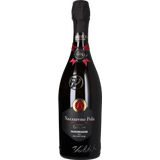Which Wine With Pasta?
Pasta and wine: What goes with what?
Water, flour and salt: It doesn't take much to create the basis for many popular dishes. Pasta dishes of all kinds are usually quick to prepare, taste great with the right ingredients and are good for the soul. The selection of the perfect wine for pasta is less simple, but don't worry, we can help.
Penne, fusilli or linguine?
With over 180 types of pasta, countless preparation options and an equally unmanageable number of wines, the basic problem is too much variety. Although dried noodles originated in China, Italian wines from the supposed homeland of pasta are usually a good bet.
Pasta is the Italian word for dough and there are several different types of dough to choose from. The classic recipe is water, durum wheat flour and table salt, but there are also versions to which egg is added or which are made from wholegrain or soy. However, the type of pasta is actually not as important for the wine as the choice of sauce.
There are a huge variety of preparation methods, but they can be assigned to three basic categories. We've identified these, picked out an important representative for each and selected the best wines to go with them.
1. Tomato Base
Hand on heart, who doesn't associate spaghetti bolognese with comfort food and childhood memories? But long-established fans of Italian cuisine may be in for a bit of a shock: The much-loved classic is not actually an authentic Italian dish at all. This tomato minced meat sauce is only served with long, narrow spaghetti outside Italy. Ragu alla bolognese is served Bologna, but with tagliatelle.
For everyone who likes to cook with wine (and put it in their food :-) ), we have good news: This dish only becomes authentic if you deglaze the basic ingredients with a dash of white wine before adding the tomatoes to the pot. When the sauce is ready (after at least two hours of cooking time), open a fruity Primitivo (you can find out everything you need to know about the Primitivo in this blog post!) such as the Primitivo di Manduria DOC.
2. Panna e cacio (cream and cheese)
Yes, yes, yes... We know that proper spaghetti carbonara shouldn't need whipped cream. Really authentic carbonara consists exclusively of egg yolk, guanciale (bacon), pecorino, salt and pepper. However, this category covers all creamy, somewhat hearty sauces and their wine accompaniments. Dry white wines such as the Friulano Ronco Cucco DOC 2018 from the Tenuta Villa Nova winery go best with these often richer sauces. If you like, you could also open a strong Sangiovese like the Le Sentinelle Morellino di Scansano Riserva.
3. Oil base
And now a drum roll for our last and favourite category! This is our favourite category because it's so wonderfully versatile and can form a perfect symbiosis with so many wines and pasta types. The basis here is high-quality olive oil. If you want to stick to a classic version, add fresh garlic, spicy chilli peppers, basil, salt and pepper. Add pasta and you'll have the perfect Spaghetti Aglio e Olio. By using different oils, fresh herbs and other ingredients such as seafood, you can create a multitude of variations. If you then slice mature Parmegiano Reggiano over it - mmmmh. But watch out! Parmesan is never served with seafood in Italian cuisine. Italians believe that the intense flavour of mature cheese masks the subtle flavours of fish, prawns and calamari.
This was actually the hardest category to pick a favourite in because so many things fit so well. We chose a Felugan Lugana DOP from the Azienda Agricola Feliciana. This Italo white wine is thoroughly beguiling and matches well with vegetarian dishes, fish and seafood. Perfect!
And since you'll no longer need to spend hours in front of the wine shelf in the future, invest the time you've saved in making homemade pasta - it'll be worth it!
Photo credits: Janko Ferlič (Unsplash)
Latest reviews
-
 3.4 (5)
3.4 (5)Georg u. Katharina Preisinger Grauburgunder Goldberg 2023, 0,75 L
- Top single vineyard white wine from Neusiedlersee
- Matured in a large wooden barrel
- Creamy, juicy & versatile
€ 10,99 (€ 14,65 / L)Delivery by January 10
-
-
 4.9 (14)
4.9 (14)Fraccaroli Lugana D.O.C. Pansere 2024, 0,75 L
- With a true fun factor
- Grape variety 100% Turbiana, the typical grape variety for Lugana
- The ideal summer wine with depth
€ 11,99 (€ 15,99 / L)Sold out
-
-
 5.0 (1)
5.0 (1)Andreola Nazzareno Pola Valdobbiadene Prosecco Superiore DOCG Extra Dry 2023, 0,75 L
Bestseller- Selection from the best vineyards
- 94 Falstaff points, impressive, elegant
- Expression of sand and limestone
€ 32,99 (€ 43,99 / L)Delivery by January 10
-
-
 4.4 (5)
4.4 (5)Domäne Wachau Wachauer Edel-Glühwein - white , 0,75 L
Bestseller- Just heat and enjoy
- Natural sugar from grape juice
- With cinnamon, star anise, cardamom and cloves
€ 7,99 (€ 10,65 / L)Delivery by January 10
-
Magazine Articles:
-
Austria: Free standard delivery from € 49,90
-
We operate in a
climate-conscious manner. -
Free
returns Secure payments
with SSL encryption technology







